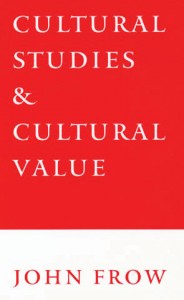 |
John Frow. Cultural Studies and Cultural Value. Oxford University Press, 1995.
Within the domain of cultural studies, the distinction between high and popular culture is perceived as a social fact that has been crucial for organization of the cultural field. The dominant position of high culture, seen as the vehicle of cultural value, has been replaced by popular culture. Frow questions this position of cultural studies, which is anathema to diversified contemporary cultural production and consumption. On the other hand, in a dialogue with the post-structuralists and the post-Marxists, he argues that in spite of the numerous changes, within the cultural field the distinction high/popular is still present. However, it should be understood and organized in a different way––less populist, more democratic, and with regard to various (class and social) positions of intellectuals. Frow develops his argument by analyzing the distinction between high and popular culture from many perspectives, but his examination of the concept “popular” is the most profound and comprehensive of the entire book. He demonstrates that detailed philosophical investigation of basic concepts, so rare in cultural studies, is the best way to be innovative and inspiring.
|